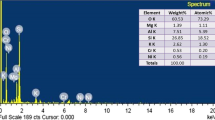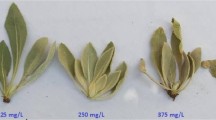Abstract
Copper (Cu) contamination has become a global concern because of industrial, agricultural, and other anthropogenic activities. In the present experiments, the toxicological effects, mechanisms, and potential toxicity thresholds were investigated in the roots of Vicia faba L. seedlings that were cultivated in Cu-amended soils (0, 6.25, 12.5, 25, 50, 100, 200, 400, and 600 mg kg−1) for 20 days, based on an analysis of the soil physicochemical properties, native Cu, available Cu, and root-enriched Cu contents. The superoxide dismutase (SOD), ascorbate peroxidase (APX), and guaiacol peroxidase (POD) isozymes and activities, as well as glutathione (GSH) and heat shock protein 70 (HSP70), changed like biphasic dose-response curves, cooperating to control the redox homeostasis. The APX and POD enzymes exhibited enhanced activities and became H2O2 scavengers primarily when the catalase (CAT) activities tended to decrease. Endoprotease (EP) isozymes and activities might be enhanced to degrade carbonylated proteins and alleviate metabolic disturbance in the roots. Additionally, HSP70 may not be suitable as a biomarker for relatively higher soil Cu concentrations and relatively longer exposure times for the roots. As a result, the isozymes and activities of SOD, CAT, and EP, as well as GSH, can be adopted as the most sensitive biomarkers. The toxicity threshold is estimated as 0.76–1.21 mg kg−1 of available Cu in the soils or 25.04–36.65 μg Cu g−1 dry weights (DW) in the roots.





Similar content being viewed by others
References
Alvarez MB, Domini CE, Garrido M, Lista AG, Fernández-Band BS (2011) Single-step chemical extraction procedures and chemometrics for assessment of heavy metal behaviour in sediment samples from the Bahía Blanca estuary, Argentina. J Soils Sediments 11:657–666
Anjum NA, Ahmad I, Mohmood I, Pacheco M, Duarte AC, Pereira E, Umar S, Ahmad A, Khan NA, Iqbal M, Prasad MNV (2012) Modulation of glutathione and its related enzymes in plants’ responses to toxic metals and metalloids—a review. Environ Exp Bot 75:307–324
Arora A, Sairam RK, Srivastava GC (2002) Oxidative stress and antioxidative system in plants. Curr Sci 82:1227–1238
Bradford MM (1976) A rapid and sensitive method for the quantification of microgram quantities of protein utilizing the principle of protein-dye binding. Anal Biochem 72:248–254
Cajaraville MP, Bebianno MJ, Blasco J, Porte C, Sarasquete C, Viarengo A (2000) The use of biomarkers to assess the impact of pollution in coastal environments of the Iberian Peninsula: a practical approach. Sci Total Environ 247:295–311
Calabrese EJ, Baldwin LA (2003) Toxicology rethinks its central belief: hormesis demands a reappraisal of the way risks are assessed. Nature 421:691–692
Craig EA, Gross CA (1991) Is hsp70 the cellular thermometer? Trends Biochem Sci 16:135–140
Cuypers A, Smeets K, Ruytinx J, Opdenakker K, Keunen E, Remans T, Horemans N, Vanhoudt N, Van Sanden S, Van Belleghem F, Guisez Y, Colpaert J, Vangronsveld J (2011) The cellular redox state as a modulator in cadmium and copper responses in Arabidopsis thaliana seedlings. J Plant Physiol 168:309–316
Distefano S, Palma JM, Gómez M, del Río LA (1997) Characterization of endoproteases from plant peroxisomes. Biochem J 327:399–405
Downs CA, Fauth JE, Woodley CM (2001) Assessing the health of grass shrimp (Palaeomonetes pugio) exposed to natural and anthropogenic stressors: a molecular biomarker system. Mar Biotechnol 3:370–397
Flammarion P, Devaux A, Nehls S, Migeon B, Noury P, Garric J (2002) Multi-biomarker responses in fish from the Moselle River (France). Ecotoxicol Environ Saf 51:145–153
Foyer CH, Noctor G (2005) Redox homeostasis and antioxidant signaling: a metabolic interface between stress perception and physiological responses. Plant Cell 17:1866–1875
Gajewska E, Skłodowska M (2010) Differential effect of equal copper, cadmium and nickel concentration on biochemical reactions in wheat seedlings. Ecotoxicol Environ Saf 73:996–1003
García-Limones C, Hervás A, Navas-Cortés JA, Jiménez-Diaz RM, Tena M (2002) Induction of an antioxidant enzyme system and other oxidative stress markers associated with compatible and incompatible interactions between chickpea (Cicer arietinum L.) and Fusarium oxysporum f. sp. ciceris. Physiol Mol Plant Pathol 61:325–337
Gomaa OM, Azab KS (2013) Biological indicators, genetic polymorphism and expression in Aspergillus flavus under copper mediated stress. J Radiat Res Appl Sci 6:49–55
Guo SH, Wharton W, Moseley P, Shi HL (2007) Heat shock protein 70 regulates cellular redox status by modulating glutathione-related enzyme activities. Cell Stress Chaperones 12:245–254
Habiba U, Ali S, Farid M, Shakoor MB, Rizwan M, Ibrahim M, Abbasi GH, Hayat T, Ali B (2015) EDTA enhanced plant growth, antioxidant defense system, and phytoextraction of copper by Brassica napus L. Environ Sci Pollut Res 22:1534–1544
Hall JL (2002) Cellular mechanisms for heavy metal detoxification and tolerance. J Exp Bot 53:1–11
Hallare AV, Pagulayan R, Lacdan N, Köhler HR, Triebskorn R (2005) Assessing water quality in a tropical lake using biomarkers in zebrafish embryos: developmental toxicity and stress protein response. Environ Monit Assess 104:171–187
Hissin PJ, Hilf RA (1976) Fluorometric method for determination of oxidized and reduced glutathione in tissues. Anal Biochem 74:214–226
Jung HI, Gayomba SR, Rutzke MA, Craft E, Kochian LV, Vatamaniuk OK (2012) COPT6 is a plasma membrane transporter that functions in copper homeostasis in Arabidopsis and is a novel target of SQUAMOSA promoter-binding protein-like 7. J Biol Chem 287:33252–33267
Lewis S, Handy RD, Cordi UB, Billinghurst Z, Depledge MH (1999) Stress proteins (HSP’s): methods of detection and their use as an environmental biomarker. Ecotoxicology 8:351–368
Lu RK (2000) Soil analytical methods of agronomic chemical. China Agricultural Science and Technology Press, Beijing (in Chinese)
Mal TK, Adorjan P, Corbett AL (2002) Effect of copper on growth of an aquatic macrophyte, Elodea canadensis. Environ Pollut 120:307–311
Marschner P (2011) Mineral nutrition of higher plants, 3rd edn. Academic Press, London
Martinez CE, Jacobson AR, McBride MB (2003) Aging and temperature effects on doc and elemental release from a metal contaminated soil. Environ Pollut 122:135–143
McQuillan JS, Kille P, Powell K, Galloway TS (2014) The regulation of copper stress response genes in the polychaete Nereis diversicolor during prolonged extreme copper contamination. Environ Sci Technol 48:13085–13092
Mittler R (2002) Oxidative stress, antioxidants and stress tolerance. Trends Plant Sci 7:405–410
Mittler R, Feng X, Cohen M (1998) Post-transcriptional suppression of cytosolic ascorbate peroxidase expression during pathogen-induced programmed cell death in tobacco. Plant Cell 10:461–473
Peng HY, Kroneck PMH, Küpper H (2013) Toxicity and deficiency of copper in Elsholtzia splendens affect photosynthesis biophysics, pigments and metal accumulation. Environ Sci Technol 47:6120–6128
Puig S, Andrés-Colás N, García-Molina A, Peñarrubia L (2007) Copper and iron homeostasis in Arabidopsis: responses to metal deficiencies, interactions and biotechnological applications. Plant Cell Environ 30:271–290
Qin LT, Liu SS, Liu HL, Zhang YH (2010) Support vector regression and least squares support vector regression for hormetic dose-response curves fitting. Chemosphere 78:327–334
Rau S, Miersch J, Neumann D, Weber E, Krauss G-J (2007) Biochemical responses of the aquatic moss Fontinalis antipyretica to Cd, Cu, Pb and Zn determined by chlorophyll fluorescence and protein levels. Environ Exp Bot 59:299–306
Rocha ACS, Almeida CMR, Basto MCP, Vasconcelos MTSD (2014) Antioxidant response of Phragmites australis to Cu and Cd contamination. Ecotoxicol Environ Saf 109:152–160
Rodrigo-Moreno A, Andrés-Colás N, Poschenrieder C, Gunsé B, Peñarrubia L, Shabala S (2013) Calcium- and potassium-permeable plasma membrane transporters are activated by copper in Arabidopsis root tips: linking copper transport with cytosolic hydroxyl radical production. Plant Cell Environ 36:844–855
Rodríguez-Serrano M, Romero-Puertas MC, Pazmiño DM, Testillano PS, Risueño MC, del Río LA, Sandalio LM (2009) Cellular response of pea plants to cadmium toxicity: cross talk between reactive oxygen species, nitric oxide, and calcium. Plant Physiol 150:229–243
Romero-Puertas MC, Mccarthy I, Gómez M, Sandalio LM, Corpas FJ, Delrío LA, Palma JM (2004) Reactive oxygen species-mediated enzymatic systems involved in the oxidative action of 2, 4-dichlorophenoxyacetic acid. Plant Cell Environ 27:1135–1148
Ruyters S, Salaets P, Oorts K, Smolders E (2013) Copper toxicity in soils under established vineyards in Europe: a survey. Sci Total Environ 443:470–477
Sharma SS, Dietz KJ (2009) The relationship between metal toxicity and cellular redox imbalance. Trends Plant Sci 14:43–50
Solomon M, Belenghi B, Delledonne M, Menachem E, Levine A (1999) The involvement of cysteine proteases and protease inhibitor genes in the regulation of programmed cell death in plants. Plant Cell 11:431–443
Souza VL, de Almeida AAF, de Souza JS, Mangabeira PAO, de Jesus RM, Pirovani CP, Ahnert D, Baligar VC, Loguercio LL (2014) Altered physiology, cell structure, and gene expression of Theobroma cacao seedlings subjected to Cu toxicity. Environ Sci Pollut Res 21:1217–1230
Stadtman ER, Levine RL (2003) Free radical-mediated oxidation of free amino acids and amino acid residues in proteins. Amino Acids 25:207–218
Van der Oost R, Beyer J, Vermeulen NPE (2003) Fish bioaccumulation and biomarkers in environmental risk assessment: a review. Environ Toxicol Pharmacol 13:57–149
Wang WX, Vinocur B, Shoseyov O, Altman A (2004) Role of plant heat shock proteins and molecular chaperones in the abiotic stress response. Trends Plant Sci 9:244–252
Wang CR, Wang XR, Tian Y, Yu HX, Gu XY, Du WC, Zhou H (2008) Oxidative stress, defense response, and early biomarkers for lead-contaminated soil in Vicia faba seedlings. Environ Toxicol Chem 27:970–977
Wang CR, Tian Y, Wang XR, Geng JJ, Jiang JL, Yu HX, Wang C (2010) Lead-contaminated soil induced oxidative stress, defense response and its indicative biomarkers in roots of Vicia faba seedlings. Ecotoxicology 19:1130–1139
Wang CR, Luo X, Tian Y, Xie Y, Wang SC, Li YY, Tian LM, Wang XR (2012a) Biphasic effects of lanthanum on Vicia faba L. seedlings under cadmium stress, implicating finite antioxidation and potential ecological risk. Chemosphere 86:530–537
Wang CR, Xiao JJ, Tian Y, Bao X, Liu L, Yu Y, Wang XR, Chen TY (2012b) Antioxidant and prooxidant effects of lanthanum ions on Vicia faba L. seedlings under cadmium stress, suggesting ecological risk. Environ Toxicol Chem 31:1355–1362
Wang CR, Liu HT, Chen JY, Tian Y, Shi J, Li DD, Guo C, Ma QP (2014) Carboxylated multi-walled carbon nanotubes aggravated biochemical and subcellular damages in leaves of broad bean (Vicia faba L.) seedlings under combined stress of lead and cadmium. J Hazard Mater 274:404–412
Xue D, Yao HY, Ge DY, Huang CY (2008) Soil microbial community structure in diverse land use systems: a comparative study using Biolog, DGGE, and PLFA analyses. Pedosphere 18:653–663
Acknowledgments
We are especially grateful to the National Nature Science Foundations of China (No. 41101294 and 20877032), the Jiangsu Government Scholarship for Overseas Studies, the Program for Innovative Research Team in Huainan Normal University (CXTD2015002) and the Foundation of State Key Laboratory of Pollution Control and Resources Reuse of China (grant No. PCRRF10020, PCRRF12014).
Author information
Authors and Affiliations
Corresponding author
Additional information
Responsible editor: Zhihong Xu
Rights and permissions
About this article
Cite this article
Xu, X., Huang, Z., Wang, C. et al. Toxicological effects, mechanisms, and implied toxicity thresholds in the roots of Vicia faba L. seedlings grown in copper-contaminated soil. Environ Sci Pollut Res 22, 13858–13869 (2015). https://doi.org/10.1007/s11356-015-5073-7
Received:
Accepted:
Published:
Issue Date:
DOI: https://doi.org/10.1007/s11356-015-5073-7




